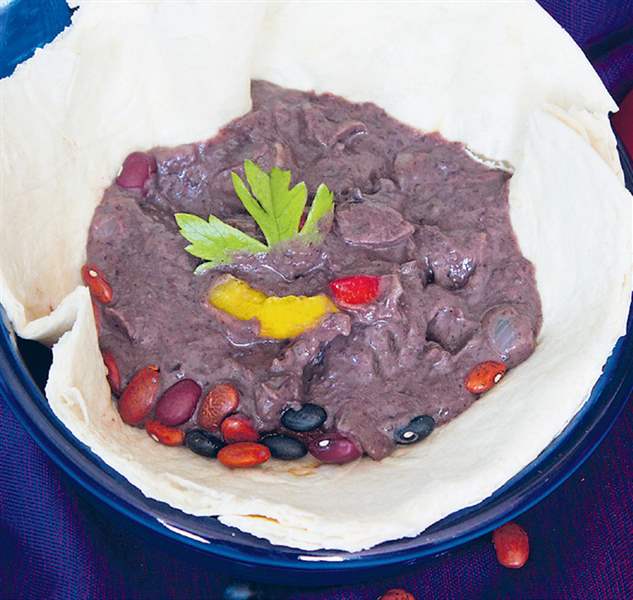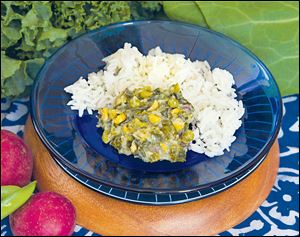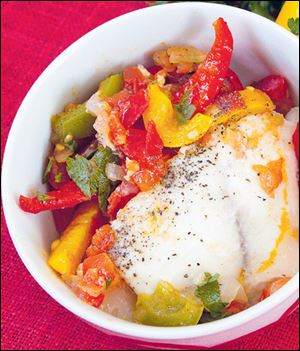
FOOD & NUTRITION
Meatless meals for Lenten Fridays
3/3/2014
Frijoles Volteados — Guatemala

Mukimo — Kenya

Pescado al Horno — Philippines
Today we feast, for tomorrow we fast.
It may be Paczki Day, Mardi Gras, Carnaval, Fat Tuesday ... pick your gleeful, gluttonous holiday. But tomorrow is Ash Wednesday, when Christians begin the period of Lent -- a time of sacrifice and penance which culminates on Easter Sunday. And during Lent, the Catholic Church’s Law of Abstinence “requires a Catholic 14 years of age until death to abstain from eating meat on Fridays in honor of the Passion of Jesus on Good Friday.” This is expected worldwide throughout the year; in practice in the United States, though, usually only Lenten Fridays are meatless.
Many people -- some Catholics included, I’ve found -- believe that it is mandated by the Church to eat fish on Lenten Fridays. And while there are many community fish frys at this time of year, offering hearty food and good fellowship, it is not actually commanded that Catholics eat fish; it is only required that they not eat meat.
Peter Feldmeier, the Thomas and Margaret Murray & James J. Bacik Professor of Catholic Studies at The University of Toledo, says that “Catholics are encouraged to use Fridays throughout the year as particular days of simplicity, including meatless foods. But Fridays in Lent is the rule on this ... It’s also about identifying with the poor in the world. So, one could observe the practice technically with lobster, but this would be absurd to the obvious intent of Lenten Fridays.”
Catholic Relief Services’ Rice Bowl program offers recipes for “meals that are simple, wholesome, and grounded in traditional indigenous cultures,” Prof. Feldmeier continues. At crsricebowl.org, you can “learn about the simple lives of peoples around the developing world, what they eat and how they live.”
For example:
- In Kenya, “Most people go to the market daily and buy food with whatever money they earned that day from their odd jobs. Buying food in small amounts is much more expensive than purchasing in larger quantities, but people cannot afford to shop for more than one day’s food at a time.”
- “Many Guatemalan children do not have access to education. For those who are able to attend school, work often gets in the way of their academics. The average years of schooling for people living in extreme poverty is 3 years, and 1.5 for those living in rural areas.”
- “Typhoon Bopha (or Pablo) was the strongest tropical cyclone ever to hit the southern Philippine island of Mindanao, taking more than 1,000 lives and destroying more than 150,000 homes in December 2012. The shelters Filipinos are building with CRS’ help in Baganga are made to withstand a typhoon and are constructed with coconut tree lumber.”

Frijoles Volteados — Guatemala
By joining Operation Rice Bowl, one of CRS’ projects, “Participants journey throughout the forty days of Lent ... offering small, suggested sacrificial gifts” to fill symbolic rice bowls. These funds -- which might be the collected money saved by serving a frugal meatless meal -- are then sent to Catholic Relief Services’ “humanitarian relief programs in nearly 100 countries worldwide.”
If you’re going to serve a meatless meal on a Lenten Friday, why resort to the traditional fish sticks with macaroni and cheese that was ubiquitous during my 13 years in Catholic schools? Take a culinary trip to Kenya, for example, and serve Mukimo. The website Village Talk, which is dedicated to Kenyan food and culture, describes it this way: “Mukimo (Moh-Kee-Moh) is a popular dish ... from central Kenya and derives its name from the word 'kima’ i.e. mash.” Or prepare the Frijoles Volteados, the “refried black beans served with every breakfast” in Guatemala, according to the website The Latin Kitchen; they are traditionally served with fried eggs. But if you don’t want to relinquish a tradition of serving fish on Lenten Fridays, but you would like to try something new and a bit exotic, then offer Philippino Pescado al Horno, or Baked Fish, with vibrant and nutritious vegetables.
These dishes, according to the CRS website, invite “Catholics to live in solidarity with our poorest and most vulnerable brothers and sisters.”
Contact Mary Bilyeu at mbilyeu@theblade.com or 419-724-6155 or on Twitter @foodfloozie.
RECIPES
- 4 large potatoes, chopped
- 1 small onion, diced
- 1-2 cloves crushed garlic
- 1/2 teaspoon salt
- 3 cups of spinach or other leafy green, chopped
- 1 16 ounce bag frozen corn
- 1 16 ounce bag frozen peas
- 2 tablespoons fair trade olive oil
Mukimo (Kenya)
Place potatoes, onions, garlic, and salt in a pot with water to cover the tops of the potatoes. Bring to a boil, then reduce to medium-high heat and simmer until potatoes are tender (about 20 minutes). Add spinach, corn, and peas, and cook until water has completely evaporated (about 5 minutes). Add olive oil, salt and pepper to taste, and sauté until spinach is tender. Remove from heat and mash entire mixture until it resembles mashed potatoes.
Frijoles Volteados (Guatemala)
- 1 onion, diced
- 2 cloves garlic, minced
- 1-2 tablespoons Fair Trade olive oil
- 2 cans black beans, with liquid reserved
- Salt to taste
- Flour tortillas
- Fried egg (optional)
Sauté onions and garlic in oil until tender. Puree beans in a blender with about 2/3 cup liquid until they become a smooth paste. Add blended black beans to onions. Stir over medium heat until thick, about ten minutes. Serve over tortillas or with a fried egg or rice.
Makes 4-6 servings.
Pescado al Horno (Philippines)
- 4 tilapia fillets, about 6 ounces each
- 1 teaspoon lemon juice
- Salt and freshly ground pepper to taste
- ⅓ cup fair trade olive oil
- 1 onion, finely minced
- 1½ cups chopped tomatoes
- ½ cup red bell pepper, cut into strips
- 1 tablespoon finely minced parsley
Preheat oven to 350°F. Season tilapia with lemon juice, salt, and pepper. Place in a shallow glass pan and set aside. Heat olive oil in a medium skillet and sauté onions, tomatoes, and pepper until soft. Pour over fish. Sprinkle with parsley. Bake for 25 minutes and serve with rice.
Makes 4 servings.